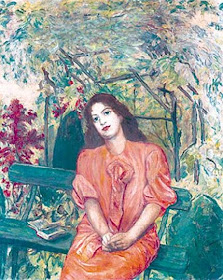 I spent the entire weekend from Friday through to Sunday helping a friend decorate her living room. I helped her choose the paper months ago and then, just before we were about to start, I had eye surgery and the whole thing was delayed for months. A couple of weeks ago we stripped the walls and half painted the ceiling.
I spent the entire weekend from Friday through to Sunday helping a friend decorate her living room. I helped her choose the paper months ago and then, just before we were about to start, I had eye surgery and the whole thing was delayed for months. A couple of weeks ago we stripped the walls and half painted the ceiling. Since then she has finished all the painting and last weekend, finally, I hung the wallpaper. I was looking for paintings in a blue/ grey tone to get inspiration for a painting for her new walls, and I came across this artist. I didn’t find the inspiration I was looking for but I did find this weeks subject for the art blog

From Wikipedia,

István Csók (February 13, 1865, Sáregres – February 1, 1961) was a Hungarian Impressionist painter. Csok lived and exhibited in Paris for a portion of his life. He became most famous in Hungary for his nudes, portraits, and landscapes of the Lake Balaton. Csok exhibited in Rome, San Francisco, Pittsburgh, and London. He won the Kossuth Prize twice.
 A couple of weeks ago I mentioned to my art tutor that I would like to do more still life, he replied that it would suit my style but be careful not to do the ‘usual flowers and fruit stuff’.
A couple of weeks ago I mentioned to my art tutor that I would like to do more still life, he replied that it would suit my style but be careful not to do the ‘usual flowers and fruit stuff’.I agreed at the time but after seeing these, I think flowers and fruit make good subject. I love the colours and shapes he has here and the fluid way in which he paints them.
He carried these colours and fluid movements on from his still lifes in to the backgrounds of his portraits. The subject often sits in a garden or beside a floral arrangement.


His more formal portraits tend to be bold paintings with bright contrasting colours.

He is little known these days but during his life time he was a popular and much respected European painter,. An example of Csók's work can be glimpsed behind the opening credits of the 1971 film Countess Dracula. This is an 1896 painting showing serial murderess Countess Elizabeth Bathory enjoying the torture of some young women: in an inner courtyard of one of her castles, naked girls are being drenched with water and allowed to freeze to death in the snow. The original painting was destroyed in World War II and so far, I’ve been unable to find a picture of it.









I can't say that this artist's work particularly appealed to me, although I did like the first and fifth paintings.
ReplyDelete